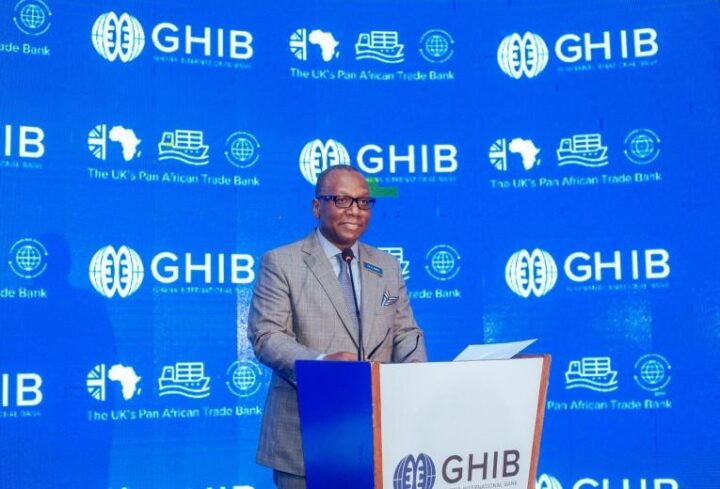The Chief Executive Officer of Ghana International Bank (GHIB), Dean Adansi, has said that Africa has the potential to generate up to $133 billion annually if it successfully closes its existing $80 billion trade finance gap. He made this known during a recent economic forum where financial experts, policymakers, and trade leaders discussed strategies to unlock the continent’s economic potential through enhanced access to trade financing.
Adansi explained that trade finance remains one of the most critical enablers of Africa’s economic growth, yet the continent continues to face significant barriers in this area. According to him, limited access to affordable financing has constrained the ability of small and medium-sized enterprises (SMEs) to participate in cross-border trade, reducing their competitiveness in regional and global markets.

He said the $80 billion trade finance shortfall, as estimated by the African Development Bank (AfDB), is stifling growth opportunities, especially in manufacturing, agriculture, and value-added sectors. “Closing this gap is not just about providing funds—it’s about enabling businesses to trade more effectively, create jobs, and expand intra-African commerce under the African Continental Free Trade Area (AfCFTA),” Adansi stressed.
The GHIB CEO emphasised that if African countries can address this financing deficit, the continent could witness an economic transformation capable of generating over $133 billion annually in additional trade value. He noted that this figure could even grow higher as more SMEs gain access to export and import opportunities.
Adansi pointed out that trade finance challenges are compounded by issues such as inadequate risk mitigation frameworks, high-interest rates, and limited technical capacity among financial institutions. He called on African governments, banks, and development partners to invest in strengthening credit guarantees, digital payment systems, and regional banking networks to make trade financing more accessible.
He also stressed the importance of leveraging technology to bridge financing gaps, saying that digital platforms can enhance transparency, reduce transaction costs, and improve the speed of cross-border payments. “If we modernise our trade finance infrastructure, we can significantly reduce the barriers that prevent businesses from accessing the capital they need,” he added.
Experts at the forum echoed his position, highlighting that improved trade finance could help African exporters meet global standards, enhance supply chain efficiency, and attract foreign direct investment. They argued that the AfCFTA provides an unprecedented opportunity for African businesses to scale beyond their local markets, but financing remains the critical missing link.
Adansi urged policymakers to prioritise reforms that promote collaboration between local banks and international lenders to improve liquidity in trade finance markets. He noted that multinational partnerships could help African financial institutions share risks and extend more competitive financing terms to businesses, particularly SMEs.
He also called on development finance institutions to play a greater role in bridging the gap, not only by providing capital but also by offering technical assistance and capacity-building programmes for African banks. This, he said, would ensure that institutions are better equipped to evaluate, approve, and manage trade finance transactions.
The GHIB chief noted that Africa’s untapped trade potential is vast, with many countries possessing abundant natural resources, youthful populations, and emerging manufacturing hubs. However, without adequate financing, these advantages cannot be fully leveraged. “Trade finance is the engine oil of commerce—without it, the wheels of trade grind slowly,” he remarked.
Some stakeholders suggested that governments explore policy incentives such as tax reliefs for exporters, reduced tariffs on trade-related inputs, and harmonised regulatory frameworks to further stimulate cross-border trade. Others emphasised the role of regional integration, noting that streamlined customs procedures and standardised documentation could complement improved financing in boosting trade volumes.
Adansi also pointed to the role of sustainability in Africa’s trade growth, urging financiers to support green and socially responsible trade projects. He argued that aligning trade finance with sustainable development goals could attract climate-focused investors while ensuring that Africa’s trade expansion is environmentally and socially inclusive.
In closing, the GHIB CEO expressed optimism that with the right mix of policies, partnerships, and technological innovations, Africa could not only close its $80 billion trade finance gap but also unlock substantial economic gains that would benefit millions across the continent. He reiterated that achieving this goal would require a united effort from governments, the private sector, and development partners.
He concluded by warning that failure to address the trade finance deficit could leave Africa struggling to maximise the opportunities presented by AfCFTA and other global trade agreements. “The time to act is now. The $133 billion opportunity is within our grasp—if we work together to make trade finance accessible to all,” he said.
Support InfoStride News' Credible Journalism: Only credible journalism can guarantee a fair, accountable and transparent society, including democracy and government. It involves a lot of efforts and money. We need your support. Click here to Donate
